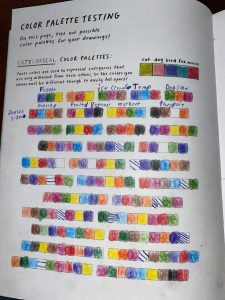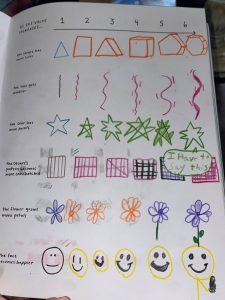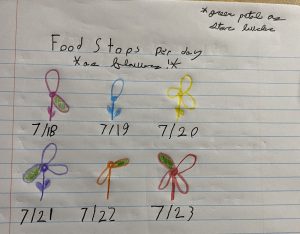The main thing I learned in religious studies 315 that data is much more malleable than one would like to believe. Someone who uses data has to be very careful with their metadata otherwise they can end up painting a maligning portrait of someone. For instance, if you showed crime statistics for an area you could say that one group could be more prone to violence than others, showing a false and harmful narrative. Even if the data is collected from an area that is wrongfully overpoliced. This would then create a false narrative and if used in a predictive algorithm, would persecute people wrongly.
Another thing I learned, is that the metadata used and on a macro level, the metadata given to users shows a company’s inherent bias, this in conjunction with my other class, display that it is very hard for an individual and by extension, systems created by individuals to be without presuppositions and biases. These then reflect in meta data where it is very hard to convey a different way of knowing as opposed to the traditional euro-American post renaissance way of thinking. For example, there exists whole other database offering tailored to indigenous people groups. Utilizing a similar but more niche set of metadata.
The final few sessions were focused on privacy, and I left those classes with a much more revitalized fear of big data. The main concern I walked away with is predictive data algorithms and virtual reality, I will be moving to the woods.
Author: clsheldon
Lab 6
I’ve been very interested in the age of local churches in Tuscaloosa. So I went about looking into the age of churches in town. I originally thought that the information would be readily accessible. This was not the case. I actually ran into an Omeka project that was trying/ had tried to do what I am doing! Their information seems to be coming out of old Tuscaloosa newspapers. My information was being pulled out of their stuff and a database of historical markers, which had the inscription on them. I think this communicates the oldest churches in town, and in my very cursory research i discovered some interesting threads that could lend themselves to more data, perhaps an affiliation chart. I used an assignment that displayed time because I thought that most relevant to what I was looking at.
Lab 5
The fields that the two platforms share in function are these. If they call it something else I’ve noted that.
Title, Description (called Summary), Creator, Source, Publisher, Date (original is added), Contributor (called Communities and protocols), Rights (called Item sharing settings), Relation (called category), Format, Language, Type, identifier, Coverage.
The Omeka model is very broad while the Mukurtu model is tailored specifically to cultural objects. The exclusive labels were reflective of this.
Cultural narrative, Traditional knowledge, Traditional Knowledge labels, People, Transcription, Geocode Address, Latitude, Longitude, Location Description, Collections
Lab 4
Looking forward I am particularly interested in biblical analysis, into my career and in this class. I am also interested in Christian history, especially in the south. It might be cool to take a look at records of when and where churches in Tuscaloosa were founded.
Early schema might include founding year, guiding bible verses, and congregation size.
Lab 2: DH Exploration
For the exploration of the digital humanities project I looked at the Baltimore Traces project, this project looks at neighborhood changes in different historic Baltimore neighborhoods, and the project looks at how people interact with these changes. One of the initial pieces of data I looked at was an interview with a juror in the trial of the Catonsville 9, this was not a case I was familiar with but with some research, one can find that it was a case regarding the trial of 9 catholic protestors burning draft information. There is a series of interviews and a blog about this event and how people interact with this piece of history.
Since the data is predominantly interview based, I understand that it might be a little more involved than just quantitative data about the movement of people (even if I would have found that very interesting). There is a lot of data here but the map looks very sparse, however, the concession would be that I am not familiar with Baltimore. The real meat is found looking at the list of data that it presents in the project drop-down tab. Lots of interviews/blogs that are relevant to the various neighborhoods. If I was the director of this assignment then I would have a clear and concise mission statement on the about drop-down. Other than there is a wealth of interpersonal knowledge to be found here.

Lab 1 Carter Sheldon
This exercise was by far my least favorite exercise I completed in the observe collect draw book. for the first couple of pallets, it was fine, but by the end of the exercise, it became a galactic pain in the butt. My hands were cramping up and trying to choose a new color without repeating the prior one was tedious.
I can see how this exercise will become important long term because you can see different colors next to one another. It served as a testing ground, however still tedious.

My favorite of the exercises was the variability exercise, It was fun trying to find ways to make the image increasingly complex, sequentially. As you see, when I was adding sides to the triangle I thought it would be interesting to add a thrid demension to the shape. Thus i added a square, then I went into 3D!
With the Star I was running out of ways to add points onto the star without it looking super tacky, so what if the star has to convey a point. thus he has been given a text bubble.

Taking what we see in the varriability excercise we can see how adding petals to flowers we can track the food stops from Prof. Weiringa’s roadtrip. When creating this I added a flower for each day on the trip, and a petal per stop for the day. Any stop at starbucks got marked in green. This was a fun way to see the effcts of color difrention.

Introduction
Hey there friends! This is Carter Sheldon and I am a Junior at Alabama looking to grab a bachelors in religious studies and a bachelor in creative media. I think that DH is relevant to my career because it sits in the intersection of my two fields of study.
This is going to be me setting up my posts…
